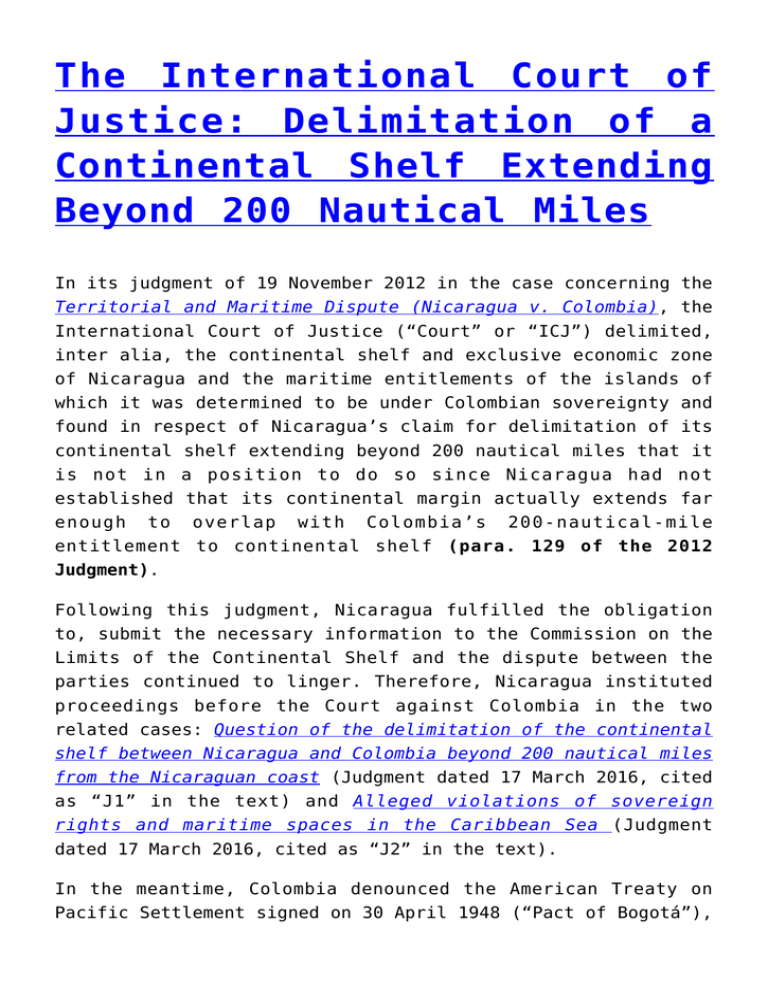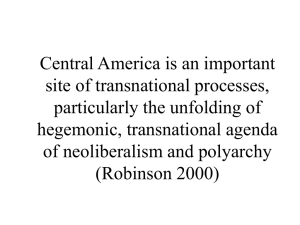The International Court of Justice: Delimitation of a Continental Shelf
advertisement

The International Court of Justice: Delimitation of a Continental Shelf Extending Beyond 200 Nautical Miles In its judgment of 19 November 2012 in the case concerning the Territorial and Maritime Dispute (Nicaragua v. Colombia), the International Court of Justice (“Court” or “ICJ”) delimited, inter alia, the continental shelf and exclusive economic zone of Nicaragua and the maritime entitlements of the islands of which it was determined to be under Colombian sovereignty and found in respect of Nicaragua’s claim for delimitation of its continental shelf extending beyond 200 nautical miles that it is not in a position to do so since Nicaragua had not established that its continental margin actually extends far enough to overlap with Colombia’s 200-nautical-mile entitlement to continental shelf (para. 129 of the 2012 Judgment). Following this judgment, Nicaragua fulfilled the obligation to, submit the necessary information to the Commission on the Limits of the Continental Shelf and the dispute between the parties continued to linger. Therefore, Nicaragua instituted proceedings before the Court against Colombia in the two related cases: Question of the delimitation of the continental shelf between Nicaragua and Colombia beyond 200 nautical miles from the Nicaraguan coast (Judgment dated 17 March 2016, cited as “J1” in the text) and Alleged violations of sovereign rights and maritime spaces in the Caribbean Sea (Judgment dated 17 March 2016, cited as “J2” in the text). In the meantime, Colombia denounced the American Treaty on Pacific Settlement signed on 30 April 1948 (“Pact of Bogotá”), which served as the jurisdictional basis in the 2012 case. Colombia raised preliminary objections against Nicaragua’s claims – those are the subject of the two latest decisions of the Court which will be shortly presented below. For the sake of brevity, not all objections presented by the Respondent will be detailed. Colombia’s main contention was that its denunciation of the Pact of Bogotá has rendered the Court without jurisdiction in respect of Nicaragua’s claims or that they were inadmissible. The Applicant, on the other hand, alleged that the Pact requires a 1-year’s notice and since the applications in the abovementioned cases have been submitted within this period, they fall entirely within the competence of the ICJ. Having regard to the principles for treaty interpretation and especially the principle of effet utile, which requires that all of the words in a treaty should be given effect, the Court decided that this preliminary objection of Colombia should be rejected since its interpretation of Article LVI from the Pact of Bogotá renders ineffective the first paragraph of the said provision (J1 paras. 41, 46). Additionally, the Respondent State tried to argue that the Court has already decided on the question of the delimitation of the continental shelf extending beyond 200 nautical miles in its 2012 Judgment by rejecting Nicaragua’s claim. Consequently, in Colombia’s view, the principle of res judicata prevents the reinstitution of this dispute. In this regard, the Court recalled its previous practice on the principle of res judicata according to which this principle requires an identity between the parties (personae), the object (petitum) and the legal ground (causa petendi). The Court added however that “[i]t is not sufficient, for the application of res judicata, to identify the case at issue, characterized by the same parties, object and legal ground; it is also necessary to ascertain the content of the decision, the finality of which is to be guaranteed.” (J1 para. 59) Examining the operative part of the 2012 Judgment and paragraph 129 thereof, the Court held that “although in its 2012 Judgment it declared Nicaragua’s submission to be admissible, it did so only in response to the objection to admissibility raised by Colombia that this submission was new and changed the subject-matter of the dispute. However, it does not follow that the Court ruled on the merits of the claim relating to the delimitation of the continental shelf beyond 200 nautical miles from the Nicaraguan coast.” (J1para. 72) Now that the condition imposed by the 2012 Judgment in order for the Court to be able to entertain Nicaragua’s claim for delimitation of its continental shelf extending beyond 200 nautical miles has been fulfilled, the Court found that the principle of res judicata does not prevent it from deciding on this question (J1para. 88). With regard to one of Colombia’s additional objections in this respect the Court noted that in any event, a recommendation made by the Commission on the Limits of the Continental Shelf on the establishment of the outer limits of its continental shelf is not a prerequisite for the task of which the Court is seised (See J1para. 114). Finally, what was of utmost importance regarding Nicaragua’s claims for violations of its sovereignty (e.g. the Applicant claimed that Colombia had started a programme of military and surveillance operations in maritime areas appertaining to Nicaragua) was the question whether by the time of institution of proceedings there existed a dispute between the parties on this issue. Colombia raised the objection that not having been previously put on notice via a diplomatic note or in another official way that Nicaragua protests its actions, this question falls outside the jurisdiction of the Court. In this respect, the ICJ recalled that the critical date for determining the existence of a dispute is the date on which the application is submitted (J2 para. 52). Colombia thus argued that “at no time up to the critical date of 26 November 2013, the date on which Nicaragua filed its Application, did Nicaragua ever indicate to Colombia, by any modality, that Colombia was violating Nicaragua’s sovereign rights and maritime zones declared by the 2012 Judgment or that it was threatening to use force.” (J2 para. 55) Having regard inter alia to the declarations and statements of senior officials of the two States made before the critical date, the ICJ decided that as far as the question of violations of the sovereignty of Nicaragua is concerned, “at the date on which the Application was filed, there existed a dispute concerning the alleged violations by Colombia of Nicaragua’s rights in the maritime zones which, according to Nicaragua, the Court declared in its 2012 Judgment appertain to Nicaragua”. (J2 para. 74) As to the alleged threat of force, however, the Court held that this issue had never been previously raised by Nicaragua, and therefore the threshold for the existence of a dispute has not been satisfied. The ICJ thus upheld in part Colombia’s second preliminary objection. (J2 para. 79) In conclusion, the above decisions of the Court, except for their clarification of certain issues relating to its jurisdiction and treaty interpretation, are of particular interest since for the first time a judicial body will have to delimit a continental shelf extending beyond 200 nautical miles. Additionally, the above mentioned finding of the Court , due to the fact that a recommendation made by the Commission on the Limits of the Continental Shelf on the establishment of outer limits is not a precondition for the delimitation of continental shelf, is likely to have implications in other such arbitrations as well. All previous judgments and advisory opinions of the ICJ (up to December 2015) as well as those of its predecessor – the Permanent Court of International Justice – which are frequently cited by other bodies, including arbitral tribunals, are summarized in the book: “World Court Practice Guide: Summaries and Index of PCIJ and ICJ Cases” (2016), author: Inna Uchkunova. The book also includes an index of the practice of the two courts where vital passages from their decisions are presented by topic for ease of reference.

